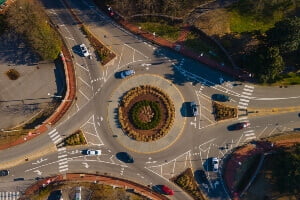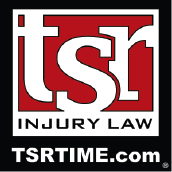Which Driver Could Be Liable For a Crash at a Minneapolis Roundabout?
 Traditional intersections with lights and stop signs have been used to control motor vehicle traffic for over a century. Did you know the first traffic light in the United States was installed in 1912? Although the total number of traditional intersections greatly exceeds the number of roundabouts, the number of roundabouts has steadily increased in recent years.
Traditional intersections with lights and stop signs have been used to control motor vehicle traffic for over a century. Did you know the first traffic light in the United States was installed in 1912? Although the total number of traditional intersections greatly exceeds the number of roundabouts, the number of roundabouts has steadily increased in recent years.
Since Minneapolis’s first roundabout was built in 1995, dozens more have been constructed – the Minneapolis Department of Transportation (MnDOT) estimates there are approximately 200 roundabouts across the state.
This is good news, as roundabouts tend to be much safer than traditional intersections. Unfortunately, crashes still happen, and victims need to know what their legal options are after a crash. TSR Injury Law’s Minneapolis-based auto accident lawyers are here to help, and there are no upfront costs for our services.
Give us a call for legal assistance. Phone: (612) TSR-TIME.
What Is a Roundabout?
You can think of a roundabout as a circular intersection. There are no traffic lights determining when a lane of traffic can proceed.
Instead, there is an island in the center with a road around it, with traffic moving in a counterclockwise direction around the island. Roundabouts are much more efficient than traffic signs or signals as they can handle high levels of traffic while maintaining better traffic flow.
Do Roundabouts Make Our Roads Safer?
MnDOT’s 2017 study of traffic safety at roundabouts had some encouraging findings:
- 80 percent reduction in fatal and serious injury crashes at roundabouts compared to traditional intersections
- 69 percent decrease in the rate of right-angle crashes at intersections with single-lane roundabouts
- 83 percent decrease in the rate of left-turn crashes at intersections with single-lane roundabouts
Part of the reason for the decrease in traffic crashes at roundabouts is that they allow a more efficient flow of traffic. It often takes seconds to proceed through a roundabout, whereas you could wait minutes to proceed through a traditional intersection.
Some of the other benefits of roundabouts include:
- The curve of the roundabout slows traffic down, which means crashes are less likely to be severe.
- Turning is less dangerous because you do not need to cut across traffic or numerous lanes to find space to make a turn.
- Vehicles travel in the same direction so there is almost no risk of head-on crashes.
- It is easier to see pedestrians at roundabouts.
What Are the Rules of the Road For Roundabouts in Minneapolis?
The rules on driving through a roundabout are not complicated:
- Vehicles that are already inside the roundabout have the right of way
- Slow down as you approach and obey the posted limit while inside the roundabout
- Proceed into the roundabout when it is safe to do so, and do not stop or pass other vehicles while inside the roundabout
- Yield to pedestrians waiting in crosswalks, just like you would at a traditional intersection
- Use your turn signal to indicate you are about to exit the circle
- Remain in your lane until you exit the circle
Pedestrians should only cross the road at designated crosswalks. There should be median islands in the middle of each offshoot of the roundabout. You can use these to safely stop and check for oncoming traffic.
Common Causes of Roundabout Collisions
Despite the benefits of roundabouts, many drivers are not used to seeing them. This can lead to confusion and negligent driving that could result in crashes.
Examples of negligent driving that could lead to a Minneapolis roundabout crash include:
Exceeding the Speed Limit
Speeding increases the risk of a crash no matter where you are. Speeding gives you less time to react to avoid a collision, especially if other drivers are behaving negligently.
Failing to Yield
Some drivers who approach the roundabout fail to yield to cars that are already in the roundabout. They may also be in a rush and try to sneak in ahead of another vehicle, resulting in a collision. Drivers might also fail to yield to bicycle riders or pedestrians.
Stopping Inside the Roundabout
Drivers who are unsure about where they are going may decide to stop to try to figure things out. However, stopping in a roundabout is illegal and incredibly dangerous. If you stop at certain points around the curve, oncoming drivers may be unable to see you, increasing the risk of a crash.
Making an Unsafe Lane Change
Drivers need to be careful about changing lanes in two-lane roundabouts. Make sure to use a turn signal and confirm you have space to change lanes safely.
Failing to Maintain a Lane
Drivers need to stay in their lane until they exit the roundabout or change lanes before exiting the roundabout.
Liability For Roundabout Crashes in Minneapolis
When a collision happens in a roundabout, those investigating what happened will need to determine which driver was negligent.
The negligent driver is going to be at fault for damages from the collision. For example, one driver may have been speeding or failing to yield to another driver who had the right of way.
Drivers cannot use ignorance as an excuse for a roundabout collision. Confusion about the rules does not relieve drivers of the obligation to follow the rules. A driver who stopped and got rear-ended may say he or she bears no fault for what happened. However, this driver broke the law by stopping. At the very least, a driver who does this is going to be partially at fault.
Every roundabout crash needs to be analyzed on its own to determine who may be at fault.
TSR has the resources to reconstruct the crash scene, gather witnesses, gather vehicle black box data, and determine how best to get you the justice you deserve.
Call To Discuss Legal Options Following a Roundabout Collision
No matter where your crash occurred, our experienced law firm may be able to help you seek compensation for medical costs and other damages. We have been strong advocates for the injured in Minneapolis for decades, having recovered more than $1 billion for our clients.
Check out our client reviews page to see what our clients have said about their experience with our firm. Client satisfaction is our number one priority, as we know this is a difficult time for you and your family.
We represent crash victims on contingency, which means there are no upfront costs for you to pay.
Unsure of your post-crash legal options? Call for assistance: (612) TSR-TIME.



